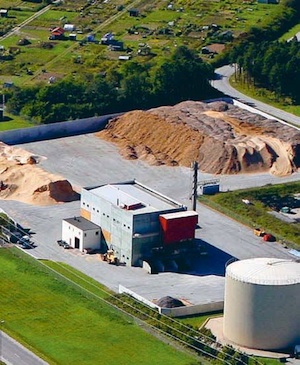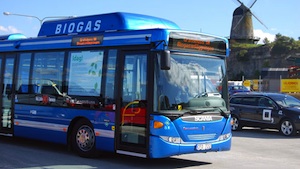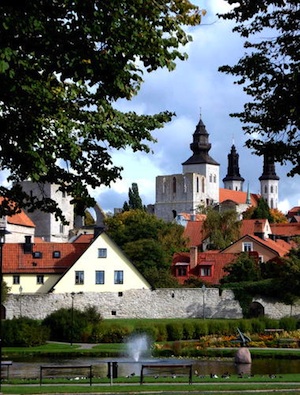Bio-fuelled district heating
A former Viking site on the island of Gotland, Visby was the main centre of the Hanseatic League in the Baltic from the 12th to the 14th century. Its 13th-century ramparts and more than 200 warehouses and wealthy merchants’ dwellings from the same period make it the best-preserved fortified commercial city in northern Europe.
Como elemento de la conservación de los edificios de Visby, construcción de una red de calefacción urbana comenzó algunos 30 Hace años. Ahora, todo el calor en el sistema de calefacción urbana de Visby se produce utilizando una mezcla de las energías renovables.
Visby’s district heating project is not an isolated case on an island where the use of renewable is guaranteed. Gotland is a showcase for a number of interesting and innovative renewable energy initiatives. This is not really surprising. Gotland has Sweden’s highest sunshine figures, enjoys good access to biofuels and is one of the best European locations for wind power. These natural assets, the entrepreneurship of the islanders and the municipality’s focus on strategic environmental planning have led to the realisation of many ideas for increasing the sustainability of Gotland’s local energy supply.
Biocombustibles en la calefacción urbana de Visby
The World Heritage City of Visby consists of many unique buildings and mediaeval ruins that are built from limestone. Algunos de sus edificios más antiguos también han bellamente tallado portales y frisos en Gotland piedra arenisca. Ambas piedras son sensibles a los contaminantes aerotransportados y, en particular, las emisiones de la quema de combustibles fósiles.
En Visby en su conjunto, cuentas de calefacción urbana de más de 80 por ciento de toda la calefacción suministrada a locales comerciales y viviendas. Para el beneficio de los residentes de Visby y el patrimonio de la ciudad, este calentamiento contribuye a una sociedad sostenible.
Environmental benefits are evident, since fossil fuels have not been used in Visby’s district heating since 2006. Calefacción urbana elimina la necesidad de transporte de combustible en las estrechas calles del centro de la ciudad de Visby. Además, the use of biofuels reduces the emission of sulphur and nitrogen oxides. En comparación con el uso de combustibles fósiles, sino que también reduce la adición neta de dióxido de carbono a la atmósfera.
Desde 1980, emisiones de azufre de la calefacción urbana de Visby se han reducido en 95 por ciento. En comparación con la calefacción individual, calefacción urbana deja el aire limpio y sano para los residentes de Visby y el patrimonio cultural sensibles de la ciudad.
La red de calefacción urbana en Visby toma el calor del:
- Ladrido, ramitas, ramas y demás (astillas) residuos de espacios forestales y aserraderos.
- Un agua de bomba de calor basada en el mar con una 11 MW.
- El biogás de vertedero ahora cerrado en Visby.
- El biogás de la planta de tratamiento de aguas residuales.
- Aceites biológicos que sustituyen a los aceites fósiles.
In addition to that, the municipality has set very high standards for energy efficiency and they have launched a new plan for the historic centre, where energy aspects are integrated with a general plan for building conservation.
Eco-Municipality of Gotland
Visby is the seat of Gotland Municipality, which took the view to become “an ecologically sustainable society within the course of a generation”. Many years ago, the Municipality of Gotland adopted a route which would lead away from fossil fuels and towards reduced climate impact. Hoy, all electricity used in the municipality’s operations is certificated as Good Environmental Choice, which means that it is produced solely from renewable energy sources.
Gotland has implemented interesting reference projects in a wide range of experiences that include wind power, biogas, solar PV and sustainable architecture. The island has been a pioneer in promoting local ownership by wind co-operatives, where around 2000 households are involved.
Actualmente, one of the smartest electricity network in the world is currently under development on the island. This allows that by using modern technology, large quantities of renewable energy sources can be integrated in the grid.
Lessons learned and replicability
Visby’s bio-fuelled district heating case shows the advantages of a smart alliance between renewable energy and heritage conservation, and can be taken as a model for many historic centres at those latitudes. This project is part of the common objective of achieving energy self-sufficiency from renewables by 2025, taking into account that the realisation of a Sustainable Energy System requires action at all levels of society.
The experience of Visby, and of Gotland in general, becomes more relevant if we take into account the geographical position of the island, in the middle of the Baltic Sea, that makes it a natural meeting place for cooperation between regions in the Baltic Sea Region.


















